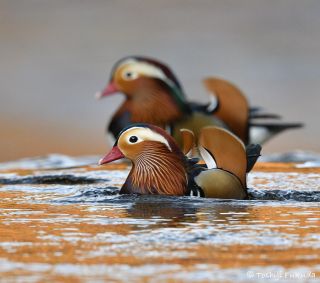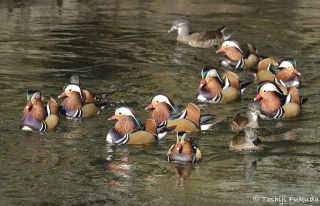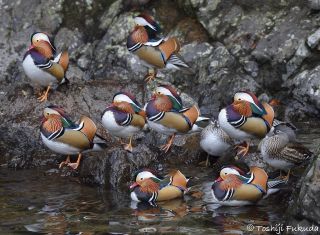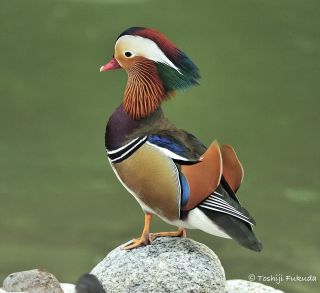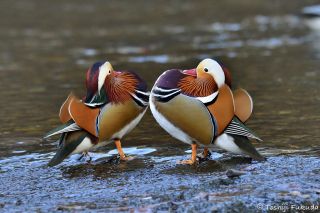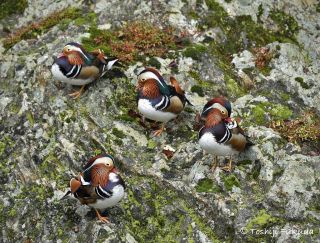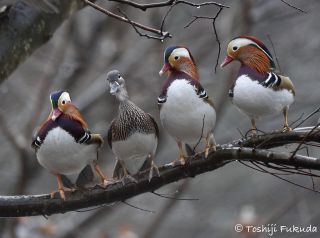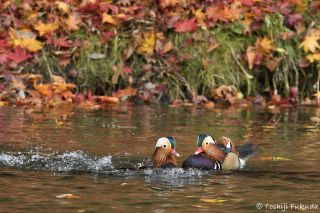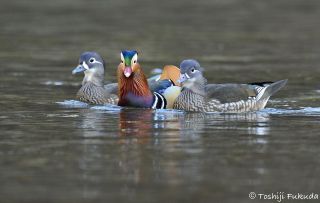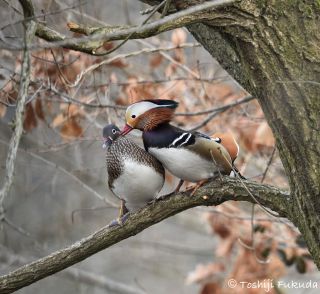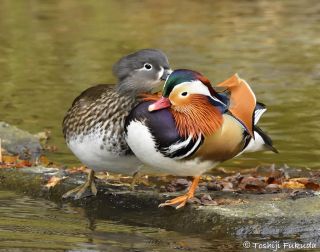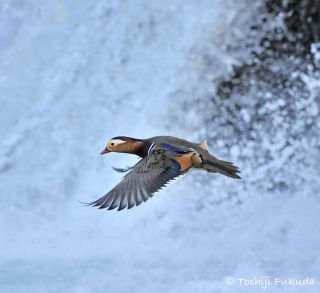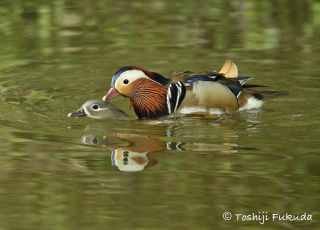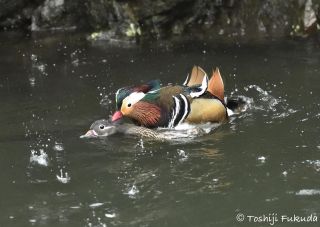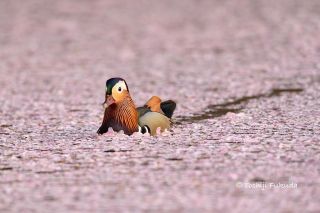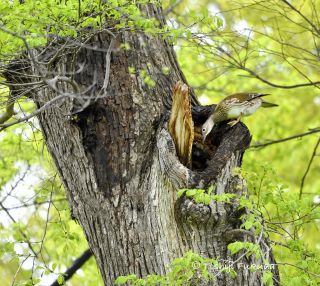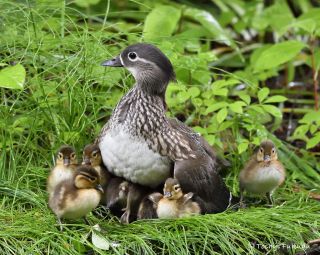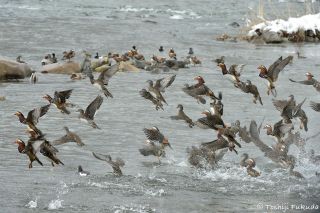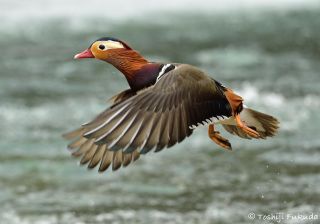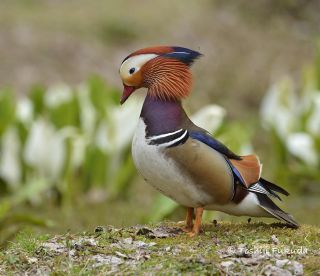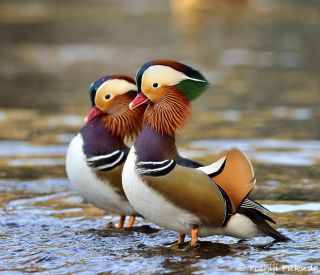Driven by female patterns of choice, Mandarin males compete with colour and demonstrative displays © Toshiji Fukuda
Mandarin: the Hooded Love Bird of the East
By Mark Brazil | Feb 28, 2017
Almost like phantoms, or moving shadows, silent shapes jump into the air, take wing and flee along a densely wooded river valley and are soon out of sight upstream. The Mandarin is a shy shade-loving bird, but catch a clear glimpse of one though and its colours shout – Oshidori.
Secretive and difficult to observe in their secluded summer habitat along mountain streams and at wooded lake sides, it is from autumn onwards, when Japan’s forest colours are brilliant enough to match even the male Mandarin’s gorgeous plumage, and during winter, that they become much easier to watch.
Then, Mandarins gather in increasingly conspicuous numbers at wooded lakes, even on moats and city park ponds in the lowlands of Japan. Even so, these wintering congregations are flighty, full of activity and prone to rising en masse forming a whirling airborne flock that flashes orange. It is during this season that the males busily posture before potential mates, whistling their intentions and showing off their finery. It is then too that avian predators such as the Northern Goshawk drive Mandarin flocks into the air and pick off their prey.
Mandarins prefer the shadiest areas of rivers, ponds and lakes. They like those places where the trees overhang casting shade on the water below, and where they can stand on a low branch over the water or on a stump at the water’s edge, or where they can forage on the ground looking for seeds and nuts, especially acorns.
On the water, the Mandarin males swim leisurely back and forth, each holding its orange “sails” high above its back like a samurai’s pennant. Their capes and ruffs are spread for the greatest effect and they puff out their chests as they try to out do each other and at the same time attract the attention of the trim grey-plumed females nearby.
The Mandarin male appears as a duck in designer clothing. In their shady woodland habitat, to the inexperienced human eye even the seemingly gaudy colours of the male are surprisingly well camouflaged, but the dappled greys and browns of the females virtually disappear against the browns of the woodland floor and in the rippled shadows on the water. Only when the males sail out into full sunlight do their colours and patterns come into their own, and then they really are splendid. Some consider them the most gorgeously plumed of all waterfowl.
Each aspect of the Mandarin’s plumage has been honed by competitive attention to detail. The elongate creamy eye stripes like designer spectacles contrasts with the dark forehead, the long orange and green crest and the orange ruff. The stubby pink bill with its yellowish-white tip at first seems out of place until it is shown in vivid contrast when it is tucked back against the dark maroon of the breast as the male rocks back on his orange feet and thrusts out his chest. A double necklace of contrasting narrow white and broad black stripes dramatically divides the maroon neck and chest from the bird’s astonishingly finely vermiculated orange flanks. The mantle and wings are resplendent in purplish black, white and orange, while the lower chest and belly are of the purest white.
If this bird seems to wear designer clothing, then its movements too seem to have been choreographed for the catwalk, mingling swagger and swish with bravado and allure. Meanwhile his suitor is clad in a cryptic blend of subtle greys, browns and cream with a delicate pair of whitish spectacles. She has all the understated elegance borne of the confidence of being in charge. It is she, not he, that chooses, while her potential mates must endlessly display and joust for her attentions.
The twin biological requisites of reproduction and survival have, through natural selection, driven avian mating systems that coincidentally entrance and delight the human eye and ear, while also at times unleashing criticism from outraged feminists. That male birds sing, display, posture and carry great adornments to show off to their mates is widely known and commonplace from the diminutive wren to the enormous peacock. The popular press meanwhile may mistakenly describe these males as being showy, flashy, or gaudy, as if they are revealing some kind of terribly chauvinistic character flaw that they should grow out of, but in reality they are being driven by biological imperative. Likewise the same press may anthropomorphize further and describe the females as drab or dull and as hoodwinked into maternal care by their lazy mates, all the while ignoring the evolutionary selective pressures that have honed their very different and very successful sexual strategies over many millions of years.
Each male Mandarin spends innumerable hours during the course of the winter and spring in showing off his finery in the hope that a female may select him as her mate. The males gather and posture, raising their crests, fluffing out their ruffs, puffing up their chests. They swim together suddenly surging through the water, showing off their strengths; meanwhile the cryptic females are watching and listening, spending their time selecting and choosing.
By spring, when the wintering flocks are breaking up, the females will have made their choices, the pairs will have formed and mating will have begun. Eventually the pairs fly off to their chosen rivers and begin carving out their territories. Each pair will seek out a mature deciduous tree in which there is a large cavity that perhaps began life as a woodpecker’s hole or as the crack left by a storm-smashed limb. If the cavity suits, and once the pair has mated several times, the female will lay her clutch of up to fourteen eggs there in the seclusion of the tree hole. For two or three more weeks during April or May the male remains nearby, perhaps to come out of seclusion to protect his mate should a predator appear, but soon he must leave or risk drawing unnecessary attention to the breeding site.
The tiny yellowish-brown chicks emerge as mere wisps of animated down, but soon they must learn the avian equivalent of base-jumping. Long before they have matured, their mother calls her chicks forth from the safety of their nest cavity, but there is only one way for them to leave it. They are clad only in their natal down and have yet to develop their feather coat so they completely lack the feathers they need for flight. So they must scrabble to the lip of their high-rise home, sometimes as much as 18 metres above the ground, then take the plunge and jump from the nest down to the woodland floor. Like tiny parachuting fluff-balls, legs and webs spread and tiny wings fluttering, they fall to bounce and land in the leaf litter far below. Then, they must make their way hurriedly to their mother and the safety of water, which may be more than a kilometre away from the nest tree. They rely on their own cryptic plumage, and her continually protective state of alert for their protection during the weeks during which they are growing. If startled or disturbed by a predator when very young they dive and flee to hide beneath the river bank, and when older they skitter and skim away across the water surface following their mother to safety. When young they are at risk from predatory fish, and mammals such as martens and tanuki (raccoon dogs), and as adults they are at risk from attack by forest-dwelling birds of prey.
Meanwhile, the brightly coloured drakes have left their mates, their breeding territories and their young behind in order to find seclusion where they can moult. The males now drop their bright plumes in favour of a more cryptic “eclipse plumage”. As with many other waterfowl, they too will drop all of their primary wing feathers at once and so become temporarily flightless. While the males are moulting the females are tending to their broods.
Once autumn returns, the males emerge from their eclipse phase into their bright nuptial plumage and once more it is time for them to compete for “love”.
The long entrenched belief, that male and female Oshidori, consort together throughout the year, much as do cranes, has led to the Mandarin having a powerful symbolical role in both the art and literature of Japan. The Mandarin is revered here as a symbol of conjugal love and affection, of marital bliss and fidelity, and paired porcelain Mandarin are a common wedding gift, while the Mandarin image appears in myriad including kimono.
For all the intricate details of the Mandarin’s colours and its pattern, it is a singular, unique feather that defines this bird. None of the more than 10,000 other avian species on Earth shares such an oddity. The drake Mandarin is the only one to carry such an instantly recognisable and highly modified wing feather, and it serves a singular purpose. This immensely asymmetric wing feather, a single tertial on each wing, has a greatly enlarged vane, which stands proud of its strongly arched rachis, while the vane below is narrow. The upper portion of the vane stands conspicuously tall like a Chinese junk’s raised sail and is brightly orange, whereas the portion of the vane below is mostly hidden and is as deep and as iridescent a blue as a Mallard’s speculum.
The name “Mandarin” for this delightful duck is perhaps derived from the fact that its distinctive orange ruff and orange sail-like wing feathers brought to mind the orange robes of the high officials in the former imperial Chinese civil service.
Its scientific generic name, Aix, is derived from an Ancient Greek word and its use attributed to Aristotle for an unknown duck, while its scientific specific name, galericulata, means the hooded one. The hooded one’s Japanese name, Oshidori, written in ancient pictograms, carries within it the meaning of love bird, and in numerous folk tales this species epitomizes both conjugal love and marital fidelity – hence its modern day appearance on wedding gifts and kimono.
Folk tales are told of the remarkable bond between the male and female and one of these was transcribed into English by that great interpreter of things Japanese, Lafcadio Hearn, in his book Kwaidan, Stories and Studies of Strange Things published in 1904 (available as a Tuttle book). Hearn relates at some length the heart-breaking tale of a falconer and hunter by the name of Sonjö who lived long ago in the northern province of Mutsu, and who destroyed the bond that ties a male and female mandarin together.
But not all tales told of the Mandarin are sad; another tells a story of affection and gratitude. A drake Mandarin captured alive and kept in a cage by a wealthy man, was pining and refusing to eat. A kind-hearted maidservant working in the wealthy man’s household persuaded the servant responsible for its care that a bird so devoted to its mate would pine until death if kept alone. Out of compassion the servant took her advice and released it. However, when the owner discovered the Mandarin’s absence he immediately suspected the servant and began treating him cruelly. Distressed by the cruelty she saw him suffering, and feeling partly responsible having given him the advice, the maid was drawn to him and in time the couple fell in love. With the power wielded by the wealthy in those days, the master sentenced the young lovers to death, without trial, for causing the loss of his valued pet. As luck would have it, before the sentence could be carried out, two messengers arrived from the provincial governor carrying the news that sentenced offenders were to be taken before the governor.
The journey to the provincial capital was a long one and overcome by fatigue the young lovers became less and less able to keep up with the messengers, until eventually they realised that they had been left behind and were lost. Eventually they came upon a rustic hut and there the exhausted lovers spent the night. To both of them, in their dreams, the messengers of the day before returned and explained that they were in fact the Mandarin they had released and his mate. Knowing of their fate at the hands of the master they had returned to rescue them. When the lovers woke the next morning the messengers had gone, but instead before the hut was a pair of Mandarin Duck, which bowed to them and then flew away into the forest. The young couple fled on, found employment in another province and were married. They had saved the magical union of the Oshidori and in return the avian messengers had made their union possible; it was a union that was to become as strong and enduring as that of the birds.
In the pending post-digital age devoted to experience, will there be anything more meaningful than spending time in deep contemplation as a natural event unfolds before us? Will an hour spent watching dancing cranes, displaying Mandarin Duck, snorkelling with dolphins, or in some other deep interaction with the natural world be rightly valued alongside time spent with loved ones? As Babul, the humble Indian taxi driver in the film “The Second Best Exotic Marigold Hotel”, so aptly said: “There is no present like the time”.
Time passes as if timeless during the deep meditation of observing the natural world.
Outro
If you have read this far, then you may enjoy my previous articles, including recent offerings such as: Red-crowned Crane Sarurun Kamuy: Our Home Grown Winter Spectacle, an Abundant Future and the End of the "Battle" (January 2017); Searching for the Grey Ghost: Kamoshika (December 2016); Dancing With The Birds of Happiness (November 2016); Duck anyone? Mallard or Muscovite? (October 2016); Damsels and Dragons: Aerial Dancers (September 2016); Halcyon Days (August 2016); Isolated in the Izu Islands (July 2016); Japan’s Ubiquitous Scavenger – The Black-eared Kite (June 2016); Oriental Stork Making a Comeback in Japan (May 2016); Daijugarami: Stepping Stone to the Arctic (April 2016); Whale Watching Japan-style: Zamami (March 2016), and Snow Monkeys & Cranes of Japan: Spectacular Winter Wildlife (February 2016).
These Wild Watch articles, and many more, can be found on this website, and on our Facebook page (please do visit and hit the “Like” button).
Author, naturalist, lecturer and expedition leader, Dr Mark Brazil has written his Wild Watch column continuously since April 1982, first in The Japan Times for 33 years, and since 2015 here on this website. All Wild Watch articles dating back to 1999 are archived here for your reading pleasure.
A collection of Mark’s essays The Nature of Japan and two handy pocket guides The Common and Iconic Birds of Japan and The Common and Iconic Mammals of Japan have been published and are also available from www.japannatureguides.com

